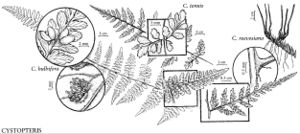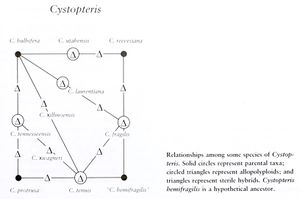Cystopteris
Neues J. Bot. 1(2): 26. 1805.
| Taxon | Illustrator ⠉ | |
|---|---|---|
 | Cystopteris bulbifera Cystopteris reevesiana Cystopteris tenuis | John Myers John Myers John Myers |
Plants terrestrial or on rock. Stems short to long-creeping, stolons absent. Leaves monomorphic, dying back in winter. Petiole 1/3–3 times length of blades, base often swollen and persisting as trophopod over winter; vascular-bundles 2, lateral, round or oblong in cross-section. Blade ovatelanceolate to deltate, 1–3-pinnate-pinnatifid, gradually reduced distally to a pinnatifid apex, membranaceous to herbaceous. Pinnae not articulate to rachis, segment margins crenulate, dentate, or serrate; proximal pinnae not reduced or 1 pair slightly reduced, sessile or petiolulate, equilateral or ± inequilateral, if inequilateral basiscopic side more narrowly cuneate; costae adaxially grooved, grooves continuous from rachis to costae; indument absent or of uniseriate, multicellular hairs in pinnae axils or of unicellular, gland-tipped hairs abaxially, absent adaxially. Veins free, simple or forked. Sori in 1 row between midrib and margin on ultimate segments, round; indusia ovate to lanceolate, hoodlike and arching over sorus toward margin, attached to receptacle base on costal side, persistent to ephemeral or often obscure at maturity. Spores brownish, echinate, or verrucate. x = 42.
Distribution
Worldwide
Discussion
Cystopteris is a taxonomically difficult genus at the species level. Especially troublesome is the worldwide and polymorphic species C. fragilis sensu lato. To maintain it as a single species with several varieties would be easiest (and least controversial). This approach, however, may not accurately reflect true evolutionary history.
Although Cystopteris species are found in temperate climates worldwide at tetraploid to octaploid ploidy levels, extant diploid species are concentrated in North America. The diploid species are relatively distinct from one another and are the progenitors of numerous allopolyploid derivatives (see reticulogram). In addition, an extinct (or undiscovered) diploid may have been involved in the origin of some polyploids (shown as "C. hemifragilis" on the reticulogram).
Considerable overlap exists among the leaf morphologies in the species of Cystopteris, even among the diploid taxa. Consequently, the key requires observation of subtle and sometimes overlapping characteristics.
Several general recommendations can be made for identifying Cystopteris. (1) Field workers should be aware that whenever Cystopteris species occur together, hybridization is likely; hybrids usually have shriveled and malformed spores. (2) Species of Cystopteris frequently occur as highly reduced plants, especially in stressful habitats such as high elevations, high latitudes, and cold and/or dry climates. Such stunted plants can be fertile, but leaf and stem characters required to distinguish species can be obscured. (3) Because of the importance of examining stem and spore features in distinguishing species, collectors should always attempt to obtain complete, fertile specimens.
Species ca. 20 (9 in the flora).
Selected References
Lower Taxa
Key
| 1 | Leaf blades elongate-pentagonal; proximal pinnae inequilateral, with enlarged basiscopic pinnules; stems cordlike, long-creeping, leaf bases more than 1 cm apart. | Cystopteris montana |
| 1 | Leaf blades elliptic to deltate; proximal pinnae equilateral or nearly so; stems not cordlike, short-creeping (leaf bases less than 0.5 cm apart) or if long-creeping, leaf bases generally less than 1 cm apart. | > 2 |
| 2 | Rachises, costae, indusia, and midribs of ultimate segments sparsely to densely covered by gland-tipped hairs; leaf blades deltate to ovate, usually widest at or near base; rachises and costae often with bulblets. | > 3 |
| 2 | Rachises, costae, indusia, and midribs of ultimate segments without glandular hairs; leaf blades elliptic to lanceolate, generally widest at or just below middle of blade; rachises and costae without bulblets. | > 6 |
| 3 | Rachises and costae frequently with bulblets; rachises, costae, indusia, and midribs of ultimate segments usually densely covered by gland-tipped hairs; leaf blades broadly to narrowly deltate, almost always widest at base, apex long-attenuate; leaves seasonally bearing sori (earliest leaves lack sori, subsequent leaves with sori); petioles reddish when young, green or straw-colored in mature specimens; spores usually 33-38 µm. | Cystopteris bulbifera |
| 3 | Rachises and costae occasionally with bulblets (often misshapen); rachises, costae, indusia, and midribs of ultimate segments usually sparsely covered by glandular hairs; leaf blades narrowly deltate to ovate-lanceolate, widest at or near base, apex short-attenuate; nearly all leaves bearing sori; petioles dark brown to straw-colored or green; spores usually 38-60 µm. | > 4 |
| 4 | Blades ovate to lanceolate, usually widest above base; spores usually 49-60 µm; ne North America. | Cystopteris laurentiana |
| 4 | Blades deltate to narrowly deltate, usually widest at or near base; spores usually 38-48 µm; e,c to sw North America. | > 5 |
| 5 | Stem scales usually dark brown, ± clathrate, cell walls dark brown, thick, luminae prominent; leaves usually with multicellular, gland-tipped hairs in axils of pinnae; sw United States. | Cystopteris utahensis |
| 5 | Stem scales usually tan to light brown, cell walls brown, thin, luminae not obvious; leaves rarely with multicellular, gland-tipped hairs in axils of pinnae; e United States (e Kansas, s Minnesota throughout East Coast area). | Cystopteris tennesseensis |
| 6 | Leaves clustered 1-4 cm behind protruding stem apex; stems pubescent, hairs yellow; spores usually 28-34 µm. | Cystopteris protrusa |
| 6 | Leaves clustered at stem apex; stems lacking hairs; spores usually 33-60 µm. | > 7 |
| 7 | Proximal pinnae pinnate-pinnatifid to 2-pinnate; stems usually long-creeping; spores usually 33-41 µm. | Cystopteris reevesiana |
| 7 | Proximal pinnae pinnatifid to pinnate-pinnatifid; stems short-creeping; spores usually 39-60 µm. | > 8 |
| 8 | Pinnae typically at acute angle to rachis, often curving toward blade apex; pinnae along distal 1/3 of blades ovate to narrowly elliptic; margins of pinnae usually crenulate or with rounded teeth; basal basiscopic pinnules of proximal pinnae cuneate to rounded at base. | Cystopteris tenuis |
| 8 | Pinnae typically perpendicular to rachis, not curving toward blade apex; pinnae along distal 1/3 of blade deltate to ovate; margins of pinnae with sharp teeth; basal basiscopic pinnules of proximal pinnae truncate to rounded at base. | Cystopteris fragilis |
"/3-3timeslengthofblades" is not declared as a valid unit of measurement for this property.
